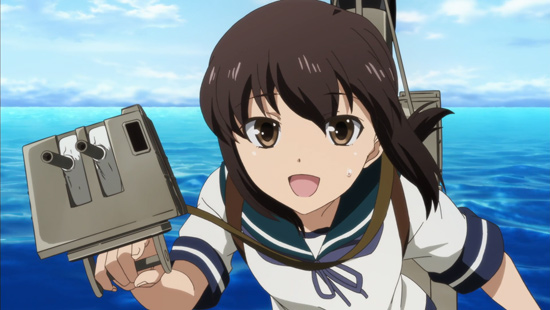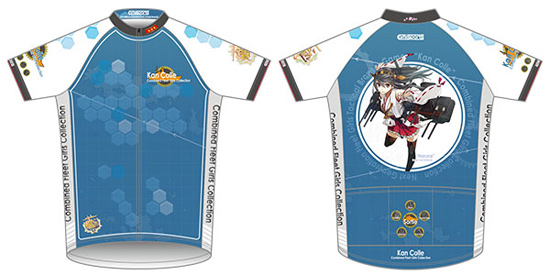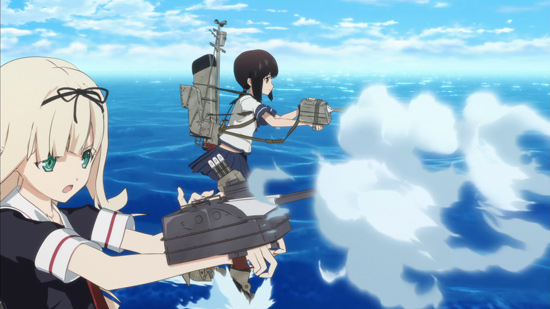
Anime fandom is not bereft of its more unexplainable trends, and even those well-versed in big name titles like Attack on Titan or One Piece can be left scratching their heads when presented with niche interests like Touhou Project, Homestuck or that whole Vocaloid business. Seemingly impenetrable to outsiders, yet clearly interesting enough to draw in plenty of fans, most of us won’t dig much deeper than asking “What the heck is that cosplayer from?” The newest of these underground fan trends, albeit one poised to become extremely popular in the near future, is Kantai Collection.
Ostensibly a series about anthropomorphic World War II battleships — taking the form of cute anime girls, of course — Kantai Collection, or “KanColle” to its fans, has sprung from its origins as an online browser game to a bonafide phenomenon consisting of video games, comics, light novels, plenty of merchandise and, of course, the aforementioned anime TV series. But if you think the KanColle is a novel new way to cash in on both anime and military otaku’s interests, think again: back in 2013, Japan Today pointed out that the idea of personifying Japanese ships as cute girls isn’t even an entirely new idea, dating back to before World War II.

First launched in 2013, KanColle began as an online card game where players organize and deploy “fleets” of battleship girls. Participants don’t have much direct control over battles, as the game’s emphasis lies in collecting and organizing your ships, er, girls. If you’re reading this and thinking you want to give it a shot, hold on a minute, because it’s not as easy as you’d expect. The game requires players have a Japanese IP address to sign up and play, requiring overseas fans to pull a few tricks in order to convince the game that they’re located in Japan. We’ll skimp on the details here, but suffice it to say, there’s ways to do it if you do a little research. Once you’ve got the IP issue figured out, you’ll have to start paying attention to the game’s daily lottery system, because you can’t just sign up for the game, you have to win the opportunity to sign up for it.

Requiring diehard fans to jump through insane hoops for something is kind of a tradition for products aimed at otaku — just look at the AKB48 promotions that prompted fans to buy multiple copies of the same album — but will no doubt scuttle the interests of plenty of potential fans unwilling to put in the effort. Unusual for a Japanese game today, KanColle is strictly designed to be played on PCs rather than a mobile device thanks to its use of Flash, which is rarely supported on mobile phones. That said, reports indicate diehard fans have sought out Flash-compatible Windows OS tablets to enable them to play the game on the go. Inevitably, these barriers raise the obvious question: Does KanColle breed diehard fans because they’re the only ones willing to expend the effort to play it, or do diehard otaku types love the game because of barriers that must be overcome just to play?
Either way, it makes sense that both an arcade trading card game by Sega and a PSP Vita game based on KanColle are on the horizon for release later this year, and neither of those will require the same effort to play. Just money. Of course, if you’re really serious (and can read Japanese), there’s a tabletop role-playing game already available.
KanColle’s popularity has been absolutely meteoric, as easily seen in Comiket data from the past couple of years. Comiket, or Comic Market, is a massive biannual event focused on doujinshi, fan-created comics, and is a useful source of information on what’s hot in the Japanese fan community. For Comiket 85, which occurred in December of 2013, KanColle was the third most popular series, in terms of doujinshi produced, behind long-time favorites Kuroko’s Basketball and Touhou Project. Keep in mind that 2013 was the year the original browser game was released, so those numbers are already impressive. Even more impressive is that a year later, for Comiket 87, KanColle had climbed to the top of the list.
Lest you think the series operates purely on fan productivity, there’s been plenty of official printed material, as well: numerous manga series, anthology books and light-novels have been released since 2013, with further releases on the horizon. More staggering than the barrage of books and manga is the sheer amount of character goods produced, as evidenced by just a cursory glance of Japanese retailer, AmiAmi. There’s the typical stuff, like PVC figures, blind box toys and t-shirts, but you’ll also find everything from mugs to plush toys to rulers (!) and keychains. Model kit companies have been quick to cash in on KanColle by re-releasing existing model kits of battleships with anime girls on the box, a marketing ploy that worked well when Girls und Panzer was at the height of its popularity a couple of years ago. The large-scale figures are the most impressive part of this merchandising onslaught, but that’s not too surprising considering that the KanColle girls, adorned with with battleship bits derived from their war-waging namesakes, seem implicitly designed to be deployed as 1/8 scale figures. The battleship turrets and accoutrements help separate them from the glut of other anime figures, while their battleship origins creates an effectively never-ending supply of inspiration for new characters.

Making the jump to animation was only a matter of time, and this season saw the debut of the Kantai Collection TV series, premiering on January 7th. The show’s full name is a mouthful, Fleet Girls Collection KanColle Animation Sequence, and is produced by animation studio Diomedea (formerly Studio Barcelona) and directed by Keizou Kusakawa. Both studio and director have long resumes consisting of decidedly unimpressive productions, which explains why the KanColle TV series is so decidedly unimpressive itself. Borrowing some basic elements from Evangelion and adding a dash of the well-worn “new girl in school” anime cliche, KanColle pairs a remarkably uninteresting narrative with some decidedly low-budget production values. Perhaps the franchise is so popular that producers knew any production would be gobbled up by enthusiastic fans regardless of its own merits, or perhaps there just wasn’t enough depth in a property based on girls imbued with the spirit of World War II battleships to turn it into an interesting narrative. Whatever the case, the TV series is squarely aimed at existing fans.
With the TV program simulcasting on Crunchyroll and the Playstation Vita game seeing release in a few months, KanColle is more accessible to non-Japanese fans than ever before. What was once the realm of dedicated Japanese otaku, or a handful of Western otaku willing to jump through a lot of hoops, the franchise’s popularity will no doubt mushroom in the coming year. Already a common sight at this year’s earliest conventions, expect KanColle cosplay to be huge at fan events this summer. It’s certainly not for everyone, but at the very least, now you’ll have an idea of what all those cosplayers are dressed as.







